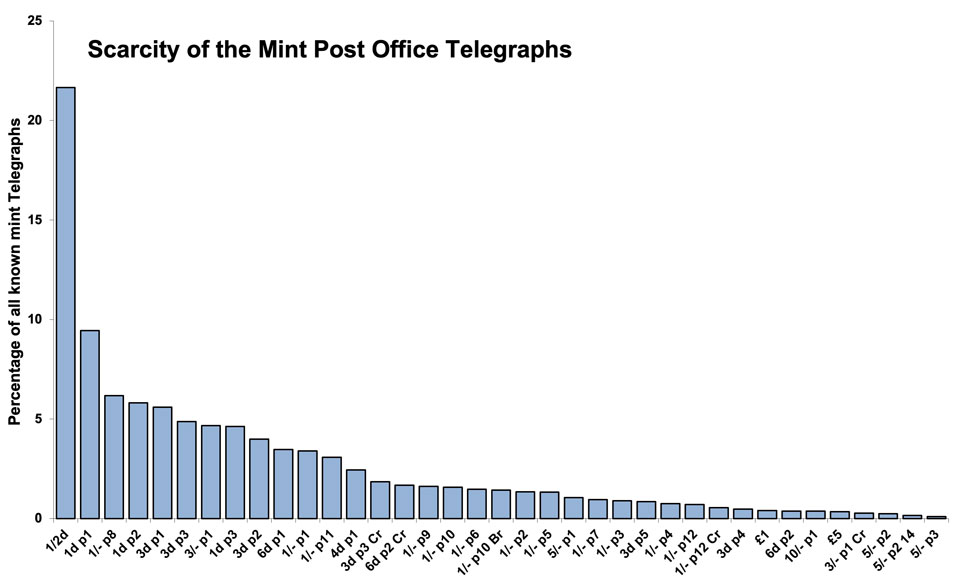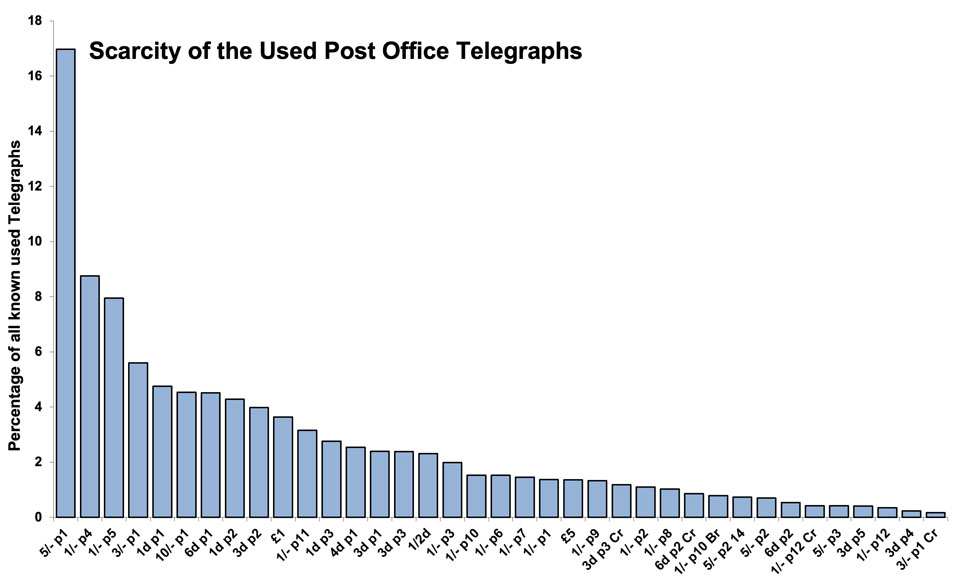
Post Office Telegraph Stamps
The history of The Post Office Telegraph Stamps of Great Britain has been described in detail elsewhere, see the bibliography, but is summarised here just to get us going.
Post Office telegraph stamps were introduced in 1876, six years after the Post Office took over the telegraph system from private companies. Initially postage stamps were used as payment, but separate accounting of the telegraph business was required and so 1d, 3d, 1s, and 5s telegraph stamps were issued in February 1876, and from May 1876 postage stamps could no longer be used. It soon became obvious that the four denominations were insufficient and a year later 4d, 6d, 3s, 10s, £1, and £5 values were issued.
In 1880 a ½d value was included to meet the requirement for certain foreign telegrams and then a year later the whole idea was abandoned. Telegraph stamps were abolished on 1 November 1881 when postage stamps could once again be used, with no further telegraph stamps issued to Post Offices after 31 October 1881.
During this period, the inland rate was 1s for 20 words, plus 3d for each additional five words or part thereof, so it’s not surprising that there were more 1s stamps printed than any other value. Rates to outlying areas were higher: to the Scilly Isles the basic rate was 3/6d, to the Orkney Islands 6s, and to the Shetlands 7s.
Mint telegraph stamps could be purchased at the Post Office but used telegraph forms and attached stamps were supposed to be destroyed once transmitted. The only legitimate used telegraph stamps were the penny stamps from receipts, but many others “leaked” out of the system and escaped destruction. This was quite sporadic, and it is worth noting that more than a quarter of existing used stamps are from just one month, December 1877.
About this Website
This website has been put together in a joint collaboration between Ian Pinwill and Paul Ramsay. It attempts to describe the extant Post Office telegraph stamps based on a database of currently around 29,000 items (last updated Feb 2024). This includes about 16,000 used, 4,000 mint, 7,500 specimens and colour trials, and 1,500 items of proof or other status recorded by Ian over the last 20+ years. It in no way professes to be complete and is a living document. It is intended to be continually updated as new and unrecorded material becomes available and the authors would be grateful to hear from any collectors of this material, both big and small, such that their holdings can be added to both the database and the website.
All proof type items (essays, die proofs, plate proofs, imprimaturs, colour standards, colour trials, specimens) are described and illustrated where possible. The site currently has over 1,500 illustrations, many of which are of large multiples, and includes all known die proofs, up to 50 per value.
Full sheet reconstructions have been created, changing Wright & Creeke’s descriptions into colour pictures, and these pictures have been used to illustrate how plate proofs and imprimaturs were taken from the sheets, generally forming recognisable patterns that relate to the warrants. The same pictures have been used to illustrate the colour trials, showing how the Specimen overprints also form patterns indicating how the sheets were divided.
The issued stamps are covered in detail with all known multiples listed and many illustrated. Used stamps are described together with earliest known, postal, fiscal and railway telegraph usage.
This website was awarded a Gold Medal at the London 2022 International Stamp Exhibition in the Philatelic Literature (Digital) category.
Other telegraph resources:
http://telstamps.org.uk
http://distantwriting.co.uk
Perfin Telegraph Stamps.pdf
About the Images
The images on this website are from scans, most from our own collections, but many have been supplied by other collectors. Some images from the Royal Philatelic Collection are reproduced by gracious permission of Her Majesty The Queen to whom copyright belongs, and some from auction archives are reproduced with permission from the auction houses. All are copyright, see the notice below.
Most images have been improved with Photoshop. They have been straightened, cropped, etc, and in some cases, where the source material is not available or of poor quality, images have been created. Such images are identified by the word “reconstruction” or phrase “computer generated image”. The striking book piece below is a typical example where the original image is from an old black and white auction catalogue. The reconstruction looks like the real deal, but should “75” be in blue or red?

Thanks to the following collectors (in alphabetical order):
Martien Blank
Mark Gibson
Derek Hencher
Andrew Higson
John Horsey
Steve Lawrie
Kevin Maunder
Chuichi Ota
Ian Pinwill
Chris Potts
Paul Ramsay
Steve Ridout
Robin Swaffield
Alex Winstone
and also to the following for allowing use of their images:
Andrew Claridge
Andrew G Lajer
BB Stamps Ltd
Grosvenor Philatelic Auctions
Spink & Son
and to Michael Sefi LVO, former Keeper of the Royal Philatelic Collection:
The Royal Philatelic Collection
About Scarcity
The description of each issued telegraph stamp includes a scarcity statement, for example the 1d plate 1 states: “Scarcity #2 in mint telegraphs, #5 in used telegraphs”. This says the mint stamp is the 2nd most common in mint telegraphs, and the used stamp is the 5th most common in used telegraphs. (#1 is common, #37 is rare.)
Click the graphs to enlarge.
Graphs are based on a database of mint and used stamps.
See “About this Website” above for details.
Copyright Notice
This website and contents are copyright © 2014-2025, all rights reserved. Any use, redistribution, or reproduction for other than personal non-commercial reasons is prohibited.
Images from auction archives are protected by the copyright of the auction houses.
Images from the Royal Philatelic Collection are reproduced by gracious permission of Her Majesty The Queen to whom copyright belongs.


